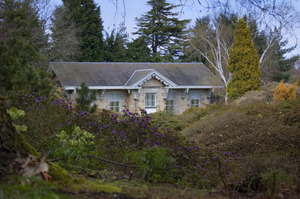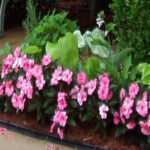Gardening under pine trees may seems to be an intimidating task; however, knowing the right plants to plant is half the battle. Make sure the plants you choose are hardy for your region, are shade loving, and knowing their watering needs will likewise help you out.
Having a front yard full of pine trees, but still wanting to have a front yard full of color can happen by planting a few of these plants. You may want to either design a garden plan or just plant plants randomly. Pick a few of these plants, prepare your ground, and get ready for some color.
Astilbes love the shade, but not extremely dry soil. Having flowers in many shades (white, ivory, pink, red, and purple), astilbes will be a great addition to any shade garden.
Azaleas love pine needles. Having Azaleas, under your pine tree will not only add color, but also give you a place to rake your needles.
Bleeding Hearts come in red, pink, and white and many come in two of these colors combined. Having humus in your soil will only enhance your Bleeding Hearts.
Brunnera is a great ground cover; however, Brunnera like soil that drains well and that is kept watered regularly.
Caladium has many different colors and varieties. Caladium leaves are heart shaped and have the color on them. Caladium does not flower and is used for its foliage.
Campanula Punctata is great for ground cover with striking flowers that attract the hummingbirds. Campanula leaves are editable and can be an added addition to your salad.
Cineraria are an annual in most places around the nation. The Cineraria flowers add daisy-like flowers to your shade bed.
Coleus has colorful foliage. Coleus is a rapid grower and if you pinch off new growth Coleus will grow fuller.
Creeping Charlie more commonly known as Ground Ivy does excellent as ground cover under the shade of the pine trees. Most consider Creeping Charlie a weed.
Daylilies come in any number of colors, sizes, and varieties. Daylilies are bulbs so they will come back year after year.
Dianthus has over 300 species. Dianthus grow in many different zones, great for the edge of your shade garden that will get some sun; moreover, Dianthus is great for drying because, they retain their color.
English Ivy works well as a ground cover and will grow up the trees.
Epimedium has many different varieties with many unique looking flowers. Epimedium is also known as Horny Goat Weed and some claim it is an aphrodisiac.
Evening Primrose is a taller plant that has flowers up and down the stalk. Evening Primrose is yellow in color and is very fragrant. The flowers of the Evening Primrose open at night and close during the day. The whole plant is editable.
Ferns need shade and many grow in the wild. Choosing a Fern may seem too many as an easy decision; conversely, there are several varieties of Fern to choose.
Hosta has beautiful foliage. There are many different varieties and will need to be split after several years.
Hydrangeas are one of very few that you can change the color of the flower, by changing the pH in the soil. Hydrangeas are great flowers for drying and do well in shade.
Impatiens do extremely well in the shade. Impatiens also need humus added to the soil. Even though Impatiens are an annual, they add vibrant color to your shade garden.
Iris has many different varieties to choose from. Very easy to grow and the Iris keeps multiplying year after year. Iris is like the gift that keeps on giving.
Japanese Anemone has light pink and white flowers. They bloom in late summer to early fall. Great for the outer edge of your shade bed, for partial sun.
Lamium has attractive foliage and petite flowers. Lamium flowers in spring as well as continues until fall.
Lily of the Valley is normally found with white or light pink bell-shaped flowers. Even with the tiny size of the flowers, they are incredibly fragrant.
Obedient Plant attracts bees and hummingbirds. Obedient Plant grows to about 4 feet tall, with spikes of flowers.
Pachysandra is a wonderful ground cover that stays green all year round. Pachysandra is great for covering ground that grass cannot grow in due to shade.
Perilla ‘Magilla’ is an annual in most place and is a lot like Coleus, with a more robust stem.
P eriwinkle is a vine-like plant that blooms from spring until first frost. Periwinkle is an evergreen and is very low maintenance.
Pieris is similar to Lily of the Valley and Bleeding Hearts. The bell-shaped flowers do best in the shade.
Pulmonaria like the morning sun; conversely, do not like the afternoon sun. Pulmonaria only bloom in spring; nevertheless, the foliage adds color to your garden also.
Rhododendrons love well draining, humus-filled soil. Planting Rhododendrons is simple and can be done at different times of the year depending on your zone.
Ribbon Grass like mint can be very invasive. Even still, Ribbon Grass is a great ground cover in areas where not much else will grow.
Snapdragons add a rainbow of colors to any garden. Planting Snapdragons along the edge of your garden in partially shady conditions will bring you the best coloring.
Solomon’s Seal is grown for its foliage. Tubular flowers that remain under the leaves hang down on Solomon’s Seal.
Tiarella is a great runner, which also forms patches. You may know Tiarella as foamflowers.
Toad Lilies have exquisite flowers. Your soil will need to be high in humus for Toad Lilies.
Violas are frequently used in shade beds. Johnny Jumpup’s can be grown in just about all the states. Great place to start when wanting to add color to your shady space.
There are a plethora of plants, some you may know, and others that you may not know, for you to choose from in your shade bed. Even though this list is not all-inclusive, it will give you a great starting point. Now get out there and garden!





